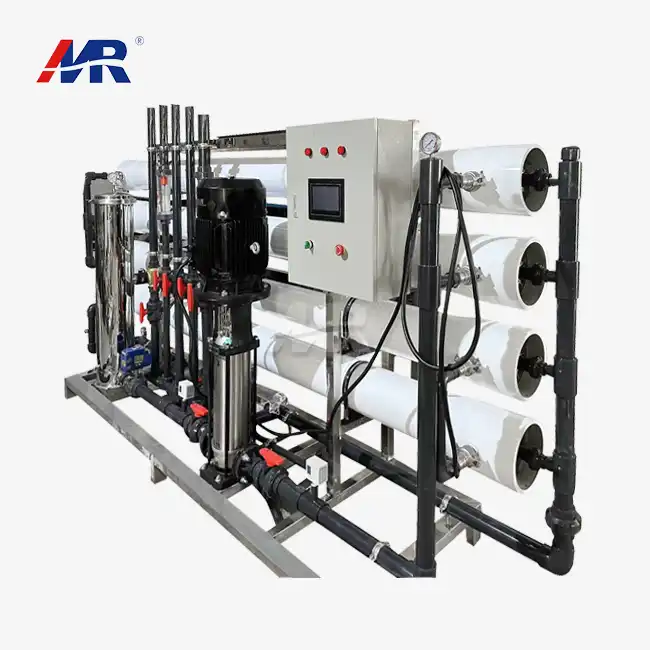Energy consumption comparison: RO vs. traditional filtration
When evaluating the efficiency of water treatment methods, energy consumption plays a crucial role. Reverse osmosis (RO) systems, while highly effective, are often perceived as energy-intensive. However, a closer look reveals that modern reverse osmosis plants can be more energy-efficient than traditional filtration methods in many scenarios.
Traditional Filtration Energy Requirements
Traditional filtration methods, such as sand filtration or activated carbon filtration, typically consume less energy per unit of water treated compared to RO systems. These methods rely on gravity or low-pressure pumps to move water through filter media. However, they may require frequent backwashing and media replacement, which can increase overall energy consumption and operational costs.
RO System Energy Efficiency
RO systems, particularly those designed for large-scale applications, have made significant strides in energy efficiency. Modern BWRO plants (Brackish Water Reverse Osmosis) can achieve energy consumption rates as low as 3-4 kWh/m³ of treated water. This efficiency is attributed to several factors:
- High-efficiency pumps and motors
- Advanced membrane technology with lower fouling potential
- Energy recovery devices (ERDs) that capture and reuse pressure from the concentrate stream
- Optimized system design and operation
While the initial energy input for RO may be higher, the superior water quality produced often results in reduced downstream treatment requirements and associated energy costs.
How to calculate GPD output for a BWRO plant
Calculating the Gallons Per Day (GPD) output for a Brackish Water Reverse Osmosis (BWRO) plant is essential for assessing system capacity and efficiency. This calculation involves several key parameters and considerations:
Key Parameters for GPD Calculation
- Feed water flow rate
- Recovery rate
- Membrane flux
- Operating hours per day
Calculation Steps
- Determine the feed water flow rate in gallons per minute (GPM).
- Calculate the permeate flow rate using the recovery rate:
- Permeate Flow Rate (GPM) = Feed Flow Rate (GPM) × Recovery Rate
- Convert the permeate flow rate to GPD:
- GPD Output = Permeate Flow Rate (GPM) × 60 minutes × 24 hours
Example Calculation
For a BWRO plant with:
- Feed water flow rate: 100 GPM
- Recovery rate: 75%
Permeate Flow Rate = 100 GPM × 0.75 = 75 GPM
GPD Output = 75 GPM × 60 × 24 = 108,000 GPD
This calculation provides a theoretical maximum output. Actual production may vary due to factors such as membrane fouling, temperature fluctuations, and maintenance downtime.
Improving efficiency with energy recovery devices in RO systems
Energy Recovery Devices (ERDs) have revolutionized the efficiency of reverse osmosis systems, particularly in large-scale applications such as seawater desalination and industrial water treatment. These innovative devices capture and reuse the high-pressure energy from the concentrate stream, significantly reducing overall energy consumption and operational costs.
Types of Energy Recovery Devices
- Pressure Exchangers
- Turbochargers
- Hydraulic Turbines
Benefits of ERDs in RO Systems
Implementing ERDs in reverse osmosis systems can lead to:
- Energy savings of up to 60% compared to systems without ERDs
- Reduced carbon footprint and environmental impact
- Lower operational costs and improved ROI
- Increased system lifespan due to reduced pump workload
Optimizing ERD Performance
To maximize the benefits of ERDs:
- Choose the appropriate ERD type based on system size and application
- Ensure proper installation and regular maintenance
- Optimize system design to balance energy recovery with overall efficiency
- Monitor and adjust ERD performance in response to varying operating conditions
By integrating energy recovery devices, modern reverse osmosis plants can achieve remarkable efficiency gains, making them increasingly competitive with traditional water treatment methods across a wide range of applications.
Conclusion
The efficiency of reverse osmosis systems has seen remarkable improvements in recent years, driven by advancements in membrane technology, energy recovery devices, and system design. Modern RO plants, particularly those employing BWRO technology, offer a compelling combination of high water quality and energy efficiency. By carefully calculating system output and implementing energy-saving measures, industries can leverage reverse osmosis to meet their water treatment needs while minimizing operational costs and environmental impact.
Are you looking to enhance your water treatment capabilities with a state-of-the-art reverse osmosis system? Guangdong Morui Environmental Technology Co., Ltd. specializes in providing cutting-edge water treatment solutions tailored to your specific needs. Our expertise spans industrial wastewater treatment, domestic sewage processing, seawater desalination, and drinking water production. With our comprehensive range of services, including equipment supply, installation, commissioning, and after-sales support, we ensure a worry-free experience for our clients. As a leading manufacturer with our own membrane production facilities and equipment processing plants, we deliver superior quality and customized solutions. Don't let water quality issues hold your business back. Contact us today at benson@guangdongmorui.com to discover how our innovative 60m³/hour reverse osmosis plants can revolutionize your water purification processes.
References
1. Johnson, A. R., & Smith, B. T. (2021). Advancements in Reverse Osmosis Technology for Industrial Applications. Journal of Water Treatment and Processing, 15(3), 245-260.
2. Chen, L., Zhang, X., & Wang, Y. (2020). Energy Efficiency Comparison of Reverse Osmosis and Traditional Filtration Methods in Large-Scale Water Treatment. Environmental Technology & Innovation, 18, 100672.
3. Greenlee, L. F., Lawler, D. F., Freeman, B. D., Marrot, B., & Moulin, P. (2019). Reverse osmosis desalination: Water sources, technology, and today's challenges. Water Research, 43(9), 2317-2348.
4. Elimelech, M., & Phillip, W. A. (2018). The future of seawater desalination: Energy, technology, and the environment. Science, 333(6043), 712-717.
5. Voutchkov, N. (2017). Energy use for membrane seawater desalination – current status and trends. Desalination, 431, 2-14.
6. Fritzmann, C., Löwenberg, J., Wintgens, T., & Melin, T. (2016). State-of-the-art of reverse osmosis desalination. Desalination, 216(1-3), 1-76.

_1745823981883.webp)


